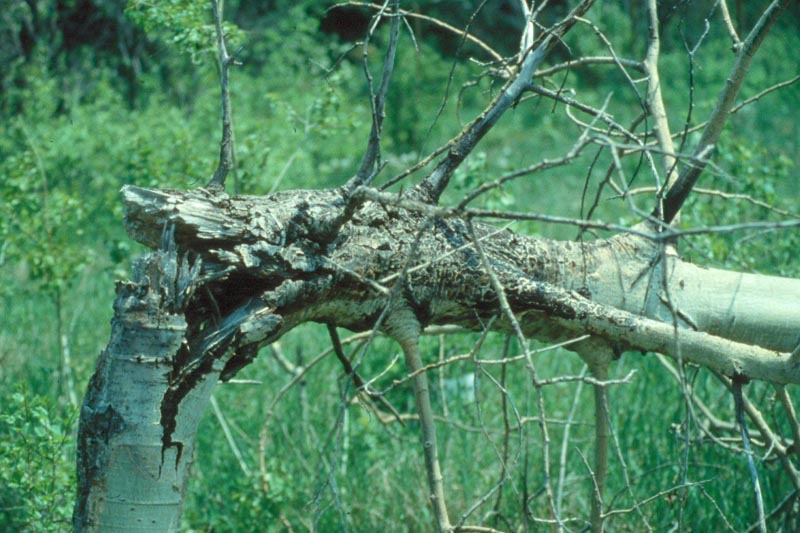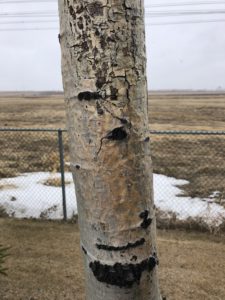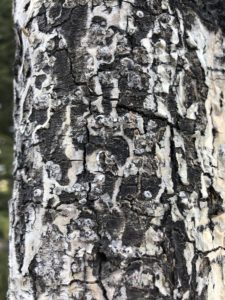Hypoxylon Canker disease is an aggressive fungal infection that targets Alberta’s aspen trees and, to a lesser extent, our balsam poplar trees. Hypoxylon Canker ruins the structural integrity of trees, eventually leading to their decline. In this post we will go over what the disease is, what it does, and how we can try to prevent it.
The Problem
Hypoxylon Canker disease is an opportunistic fungal disease that infects trees both in good health and poor, but has far more success infecting weakened or dying trees. Hypoxylon Mammatum fungal infections have 3 stages of development and usually kills its host within four to eight years after infection.
The first stage is when the fungal spores make their way to their new host by wind, wind blown rain, or insect activity. The spores are released in wet conditions around 0 degrees Celsius or above. When the spores land on young, thin bark or open wounds the fungus will settle in and begin invading the trees sapwood cells. Aspen tree bark is toxic to the fungus so the canker must enter the wood underneath without trying to get through mature bark. The fungus has more success starting its invasion from old wounds than from thin bark. The invaded area will turn yellow-orange and start to darken to red-brown where the infection is oldest. The entire area will become sunken and may ooze dark sap. Over the first year the bark will turn grey-black and crack. The first stage develops over a year before advancing to stage two.
The second stage of infection happens during the second year of infection and is seen when the outer layers of bark rupture, revealing the powdery gray masses of asexual spores underneath. These spores are reproduced each year and help advance the spread of the infection.
The third stage occurs during the fall of the third year of infection. The infection will start developing light gray lumps at the center of the infected site while the bark sloughs off. These lumps are the fruiting bodies that produce sexual spores, which can then spread the infection to other trees. The fruiting bodies will darken over time, turning dark grey. The third stage can last several years as the tree declines.
Hypoxylon Canker advances so rapidly that infected trees are not able to build callouses and compartmentalize the infection. As the fungus spreads and decays the wood, the tree will often fail at the point of infection.
The Victims
Trembling aspens are the main target for Hypoxylon Canker, but it can also infect other aspen species and, to a lesser extent, balsam poplar. The canker fungus is opportunistic, taking advantage of existing wounds or deadwood near the main trunk where the fungus can spread across a larger area. It can also infect areas with thin bark like small new branches within the canopy.
The Symptoms
Hypoxylon Canker infections can look different depending how far along the infection is in its fungal development. The first stage/year of development can be identified by sunken discoloration ranging from pale yellow or orange and darkening to red or brown. The edges of the infection are lighter with the center being darkest. Eventually the bark at the center of the infection will turn black or dark grey and start to crack. The second stage is identified by the dead bark opening and a powdery gray substance being underneath. During the third stage/ year of infection the bark will slough off and the center of the infection will form dark grey lumps, while the second stages and first stages are still seen on the outsides of the infection.
Eventually the infection will spread around the trunk and cause the canopy to have smaller leaves than usual, if it has any leaves at all. If the infection is on a branch, then more isolated areas with smaller leaves will result. The leaves that do grow on infected stems or branches will wilt and drop far sooner than usual that fall. It is expected that the tree will fail and break at the infection site before the tree is fully dead due to the degeneration of the trees structural integrity.

What can be done
Currently, there is no treatment for Hypoxylon Canker so the best treatment is prevention. Healthy trees are less at risk of infection, as well as better at preventing severe infection. Drought stressed trees are more susceptible to infection, even if the fungus has less opportunity to spread. To help prevent Hypoxylon Canker infection you can do the following:
- Monitor your trees. Finding the infections early and removing the infection is key. If a tree is found with a trunk infection, then the tree should be removed as soon as possible. The fungus can still spread even when cut down so be sure to have the infected wood removed from site, burned, or buried. If the infection is found on a branch, then the branch should be removed at least 8 inches back from the infection and the wood disposed of. Ensure that pruning is done correctly, in order to promote healing and reduce future infections.
- Maintain tree health. Have deadwood removed regularly and ensure the trees’ structure will not cause future wounds or weakness. Have your trees treated with fertilizer or insecticide as needed, along with ensuring the tree is getting the proper amount of water.
Due to the fast-growing nature of aspens and poplars and their susceptibility to canker, it is important that you consider access for pruning and removal. These species are affordable to plant but can become very expensive to work on due to their size and shape.
Professional Reference
Denise Allen, ISA Certified Master Arborist, February 24th, 2021.
References
Andre Lavallee, Forestry Canada Information Leaflet LFC 21, “Hypoxylon Canker of Aspens”
Michael E.Ostry and Jared M.LeBoldus, revised from Thomas E.Hinds and Mark O.Harrell, United States Department of Agriculture, “Diseases of Trees In The Great Plains- Hypoxylon Canker of Aspens”
https://digitalcommons.usu.edu/cgi/viewcontent.cgi?article=6839&context=aspen_bib




Comments are closed